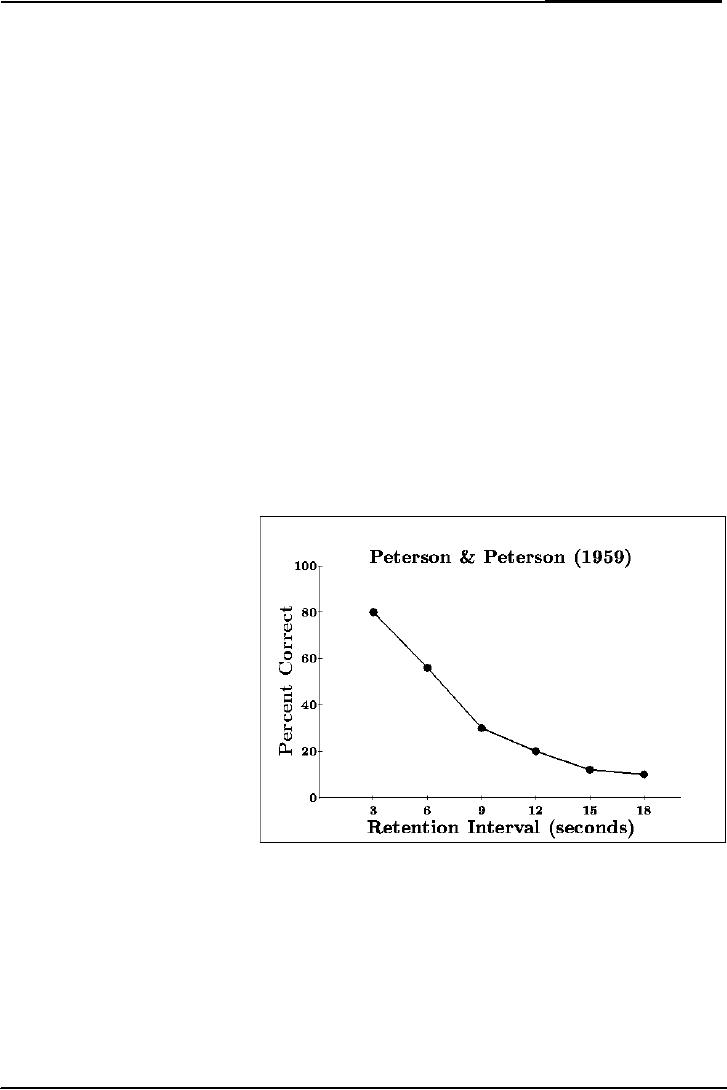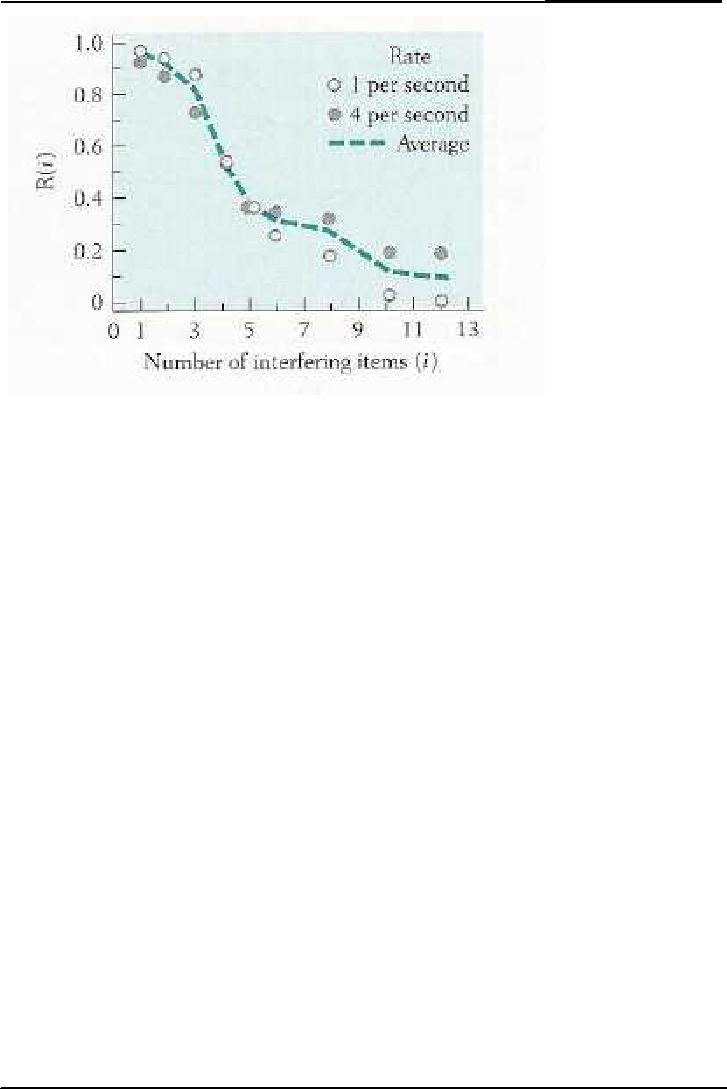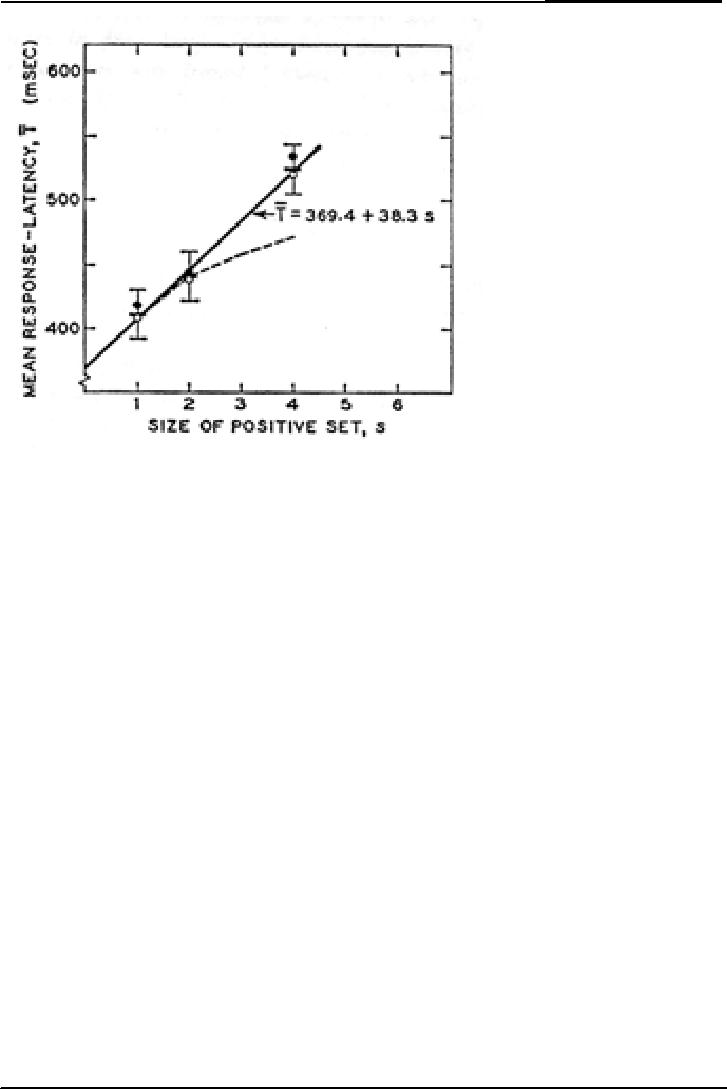 |
MEMORY:Rate of forgetting, Size of memory set |
| << MEMORY:Short Term Working Memory, Atkinson & Shiffrin Model |
| Memory:Activation in a network, Magic number 7, Chunking >> |

Cognitive
Psychology PSY 504
VU
Lesson
24
MEMORY
Short
Term working memory
(continued)
Short
term working memory is a
kind of memory that we use
for functioning, for all
our conscious
awareness
functioning. It is distinct from
long term memory because it
is not a store house
of
information.
It keeps things for a very
short time. An important
model of short term
working
memory
was given by Atkinson and
Shiffrin.
Rate
of forgetting
Information
in Short Term Memory is lost
rapidly unless it is preserved
through rehearsal.
Perhaps
the most characteristic
feature about information in
working memory is that if we do
not
do
something special to keep it
active, its activation will
rapidly decay away and we
will lose
access
to the information.
Peterson
& Peterson (1959) conducted an
experiment to illustrate the
transient character of
short
term
memory at Indiana University.
They had subjects study
three consonants (KCB) and
then
asked
for recall of the letters
after various
intervals
of time up to 18 seconds. And then
had subjects count backward
by three during the
retention
interval. Thus, following
presentation of the letters,
subjects might be asked to
count
backward
by threes as fast as possible
from 506, 509, 512
and so on. They asked
subjects count
backward
until the signal
(light).
This
diagram is showing
the
results.
There is
retention
interval
on X-axis and there
is
percent
correct on y-axis.
Implications
Peterson
and
Peterson
concluded.
Information in STM
decays
very quickly. In 18
seconds
subjects
are
performing
at less than 20%
accuracy
level. But is it
decay
or
interference?
For
giving this answer of
this
question
Waugh & Norman
(1965)
conducted a
clever
experiment.
They said decay is
due
to interference. In their
experiment
they presented list of16
single digits. The last
digit (probe) had occurred
only once
before
in the list. The task
was to report the letter
after the probe. For
example the list is
...1,
2,7,6,8,
2 the correct answer = 7.
Subject had to listen list
and then reported what is
the last
number
of last word. They varied
the number of interfering
items. They varied the
rate as 1 digit or
4
digits per second. The
purpose of varying the rate
of presentation was that
they thought when
we
vary the presentation then
we can capture time
factor.
72

Cognitive
Psychology PSY 504
VU
This
diagram is showing the
results. There is number of
items on X-axis and there is
Rate on y-
axis.
Blank circles show the
rate of presentation. One
digit per second is showed
by empty
circles.
Four digits per second
are showed by black circle.
The difference between black
and
white
circles is not significant.
But when we increase number
of interfering items the
decay is
increasing.
Because of interfering items
the short term memory is
becoming impaired.
They
concluded
that loss of memory is due
to interference of other
task.
A
practical experiment for
student
Read
digits 0-9 in a random order
such as 7 3 4 9 6 8 2 to a friend.
Try
reading lists ranging from
five digits to 10
digits.
And
then make a note of how
many digits your friend
can recall correctly.
Implications
Waugh
& Norman (1965) concluded
that it is difficult to maintain
information in working
memory.
It
has a limited capacity.
Information decays quickly in
working memory. If unattended
the items in
working
memory will rapidly decay
away in their level of
activation.
Some
people gave the idea
that there are some
slots in working memory.
Working memories
have
a fixed number of
slots?
What
is the problem?
We
are aware of many things in
our environment at the same
time.
Fixed
number of slots is
not
the
issue. The problem is how to
keep things that have
disappeared active in the
working
memory.
The problem is that
information rapidly decays in
its level of
activation.
There
are limitations on how many
items one can maintain in
working memory. Theses
limitations
are
determined by how many items
one can rehearse before
they decay away.
Size
of memory set
An
experiment was conducted by
Sternberg in 1969.
In
his experiment he presented
subjects with a memory set
of digits ( 3, 4, 8, 1) to hold in
short
term
memory. He then presented a
test digit, and subjects
were required to determine
whether it
was
in the memory set. He varied
the size of memory set
from 1 digit to 6.
73

Cognitive
Psychology PSY 504
VU
This
figure is showing the
result. There is a nearly
linear relationship between
memory-set size
and
judgment time. The size of
memory set slows down
judgment time whether the
items are
letters,
words, colors, and so on,
with all kinds of subject
populations, and in all
kinds of mental
states.
Implications
Sternberg
argues that subjects compare
target letter with each
letter in the set. The
time taken by
each
comparison is 38ms.
His
model was called Serial
processing model.
Anderson
proposes that target letter
is compared with all the
letters at the same time;
the duration
increases
because the activation is
spread across
letters.
Working
Memory: an activation
model
The
items in working memory are
defined by a high level of
activation, which enables
reliable and
rapid
access to them. If unattended
the items in working memory
will rapidly decay away in
their
level
of activation. One can
maintain items in working
memory by rehearsing them
and keeping
them
in a highly active state.
There are limitations on how
many items one can
rehearse before
they
decay.
74
Table of Contents:
- INTRODUCTION:Historical Background
- THE INFORMATION PROCESSING APPROACH
- COGNITIVE NEUROPSYCHOLOGY:Brains of Dead People, The Neuron
- COGNITIVE NEUROPSYCHOLOGY (CONTINUED):The Eye, The visual pathway
- COGNITIVE PSYCHOLOGY (CONTINUED):Hubel & Wiesel, Sensory Memory
- VISUAL SENSORY MEMORY EXPERIMENTS (CONTINUED):Psychological Time
- ATTENTION:Single-mindedness, In Shadowing Paradigm, Attention and meaning
- ATTENTION (continued):Implications, Treisman’s Model, Norman’s Model
- ATTENTION (continued):Capacity Models, Arousal, Multimode Theory
- ATTENTION:Subsidiary Task, Capacity Theory, Reaction Time & Accuracy, Implications
- RECAP OF LAST LESSONS:AUTOMATICITY, Automatic Processing
- AUTOMATICITY (continued):Experiment, Implications, Task interference
- AUTOMATICITY (continued):Predicting flight performance, Thought suppression
- PATTERN RECOGNITION:Template Matching Models, Human flexibility
- PATTERN RECOGNITION:Implications, Phonemes, Voicing, Place of articulation
- PATTERN RECOGNITION (continued):Adaptation paradigm
- PATTERN RECOGNITION (continued):Gestalt Theory of Perception
- PATTERN RECOGNITION (continued):Queen Elizabeth’s vase, Palmer (1977)
- OBJECT PERCEPTION (continued):Segmentation, Recognition of object
- ATTENTION & PATTERN RECOGNITION:Word Superiority Effect
- PATTERN RECOGNITION (CONTINUED):Neural Networks, Patterns of connections
- PATTERN RECOGNITION (CONTINUED):Effects of Sentence Context
- MEMORY:Short Term Working Memory, Atkinson & Shiffrin Model
- MEMORY:Rate of forgetting, Size of memory set
- Memory:Activation in a network, Magic number 7, Chunking
- Memory:Chunking, Individual differences in chunking
- MEMORY:THE NATURE OF FORGETTING, Release from PI, Central Executive
- Memory:Atkinson & Shiffrin Model, Long Term Memory, Different kinds of LTM
- Memory:Spread of Activation, Associative Priming, Implications, More Priming
- Memory:Interference, The Critical Assumption, Limited capacity
- Memory:Interference, Historical Memories, Recall versus Recognition
- Memory:Are forgotten memories lost forever?
- Memory:Recognition of lost memories, Representation of knowledge
- Memory:Benefits of Categorization, Levels of Categories
- Memory:Prototype, Rosch and Colleagues, Experiments of Stephen Read
- Memory:Schema Theory, A European Solution, Generalization hierarchies
- Memory:Superset Schemas, Part hierarchy, Slots Have More Schemas
- MEMORY:Representation of knowledge (continued), Memory for stories
- Memory:Representation of knowledge, PQ4R Method, Elaboration
- Memory:Study Methods, Analyze Story Structure, Use Multiple Modalities
- Memory:Mental Imagery, More evidence, Kosslyn yet again, Image Comparison
- Mental Imagery:Eidetic Imagery, Eidetic Psychotherapy, Hot and cold imagery
- Language and thought:Productivity & Regularity, Linguistic Intuition
- Cognitive development:Assimilation, Accommodation, Stage Theory
- Cognitive Development:Gender Identity, Learning Mathematics, Sensory Memory